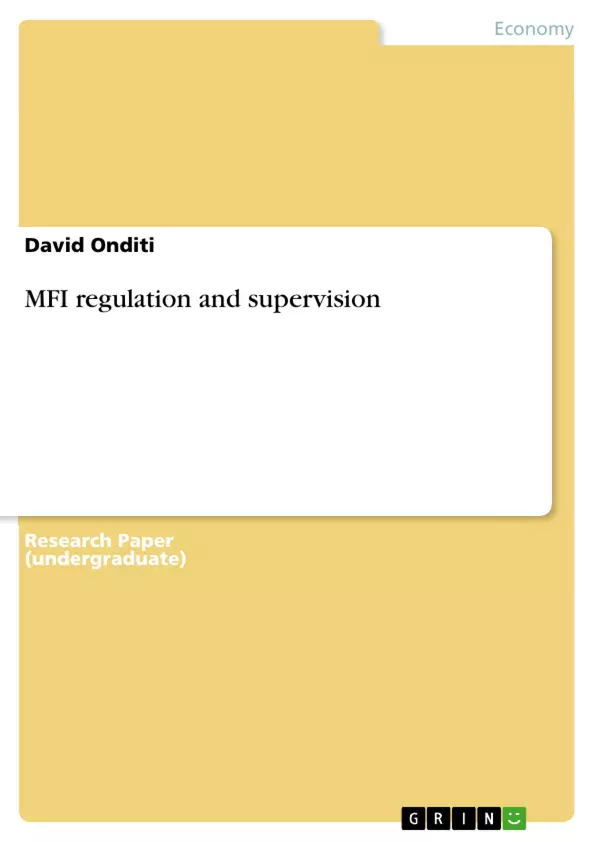There are a number of key principles of microfinance regulations. However, empirical research indicates that some key principles such as governance, and capital adequacy should be the main focus of the microfinance regulation and supervision. CGAP (2012) developed the Consensus guideline for the supervision and regulation of the microfinance institutions (MFIs). CGAP indicated that the MFIs should have a higher capital adequacy ratios as compared to the commercial banks since the microloans issued by the MFIs have insufficient security and the borrowers main motivation to repay the loans is the expectation that they would receive more loans. The MFIs are at a higher risk of loan delinquency contagion that can lead to a significant increase in the de-capitalization. Berger agreed with the above view by stating that MFIs need to have minimum capital adequacy as a means of helping the organizations to overcome the volatilities. The researcher thus concurs that capital adequacy should be a key principle in the regulation and supervision of the MFIs due to the volatilities associated with low collateral quality in the MFI loans, and increased risk of loan repayment delinquency. However, the principle should only apply to the MFIs that offer uncollateralized loans or in the cases where the security is not adequate to effectively cover the loan.
Inhaltsverzeichnis (Table of Contents)
- Introduction
- What are the key principles of microfinance regulation and supervision?
- Capital adequacy
- Governance
- Foreign exchange and liquidity risk
- When is microfinance regulation and supervision needed?
- Conclusion
Zielsetzung und Themenschwerpunkte (Objectives and Key Themes)
This research explores the key principles of microfinance regulation and supervision, particularly focusing on capital adequacy, governance, and foreign exchange and liquidity risks. It aims to understand why these principles are essential for the stability and sustainability of microfinance institutions (MFIs).
- Key principles of microfinance regulation and supervision
- Capital adequacy requirements for MFIs
- The role of governance in MFI sustainability and outreach
- Management of foreign exchange and liquidity risks in MFIs
- Empirical evidence on the effectiveness of regulation and supervision for MFIs
Zusammenfassung der Kapitel (Chapter Summaries)
The introduction provides an overview of the growing importance of microfinance in providing financial services to the poor. It highlights the debate surrounding the regulation and supervision of MFIs and outlines the research questions addressed in the paper.
The chapter on the key principles of microfinance regulation and supervision focuses on several critical areas, including permitted activities, capital adequacy, governance, foreign exchange and liquidity risk, loan documentation, and reporting. The chapter discusses the proportionality principle, which emphasizes the need for tailored regulatory frameworks for MFIs.
The section on capital adequacy explores the rationale behind stricter capital adequacy requirements for MFIs compared to commercial banks. It highlights the unique characteristics of microloan portfolios, such as higher delinquency risks and the potential for contagious loan repayment delinquency. The chapter also examines empirical research findings on the optimal capital buffer for MFIs.
The chapter on governance emphasizes the importance of strong and independent boards with expertise in banking, finance, and customer understanding. It discusses the role of corporate governance in ensuring the sustainability and outreach of MFIs, drawing on empirical studies that have explored the impact of governance mechanisms on MFI performance.
The chapter on foreign exchange and liquidity risk highlights the need for MFIs to manage currency risks effectively, particularly when transacting or borrowing in foreign currencies. It examines empirical research on the exposure of MFIs to liquidity and foreign exchange risks.
Schlüsselwörter (Keywords)
Microfinance regulation and supervision, capital adequacy, governance, foreign exchange and liquidity risk, microfinance institutions (MFIs), prudential principles, proportionality principle, empirical research, sustainability, outreach, deposit-only microfinance institutions, Basel Core Principles, delinquency risk, contagious loan repayment delinquency, covariant risks, market saturation, board independence, internal governance mechanisms, board diversity, currency risk management.
- Citar trabajo
- International Business Management David Onditi (Autor), 2019, MFI regulation and supervision, Múnich, GRIN Verlag, https://www.grin.com/document/477467



